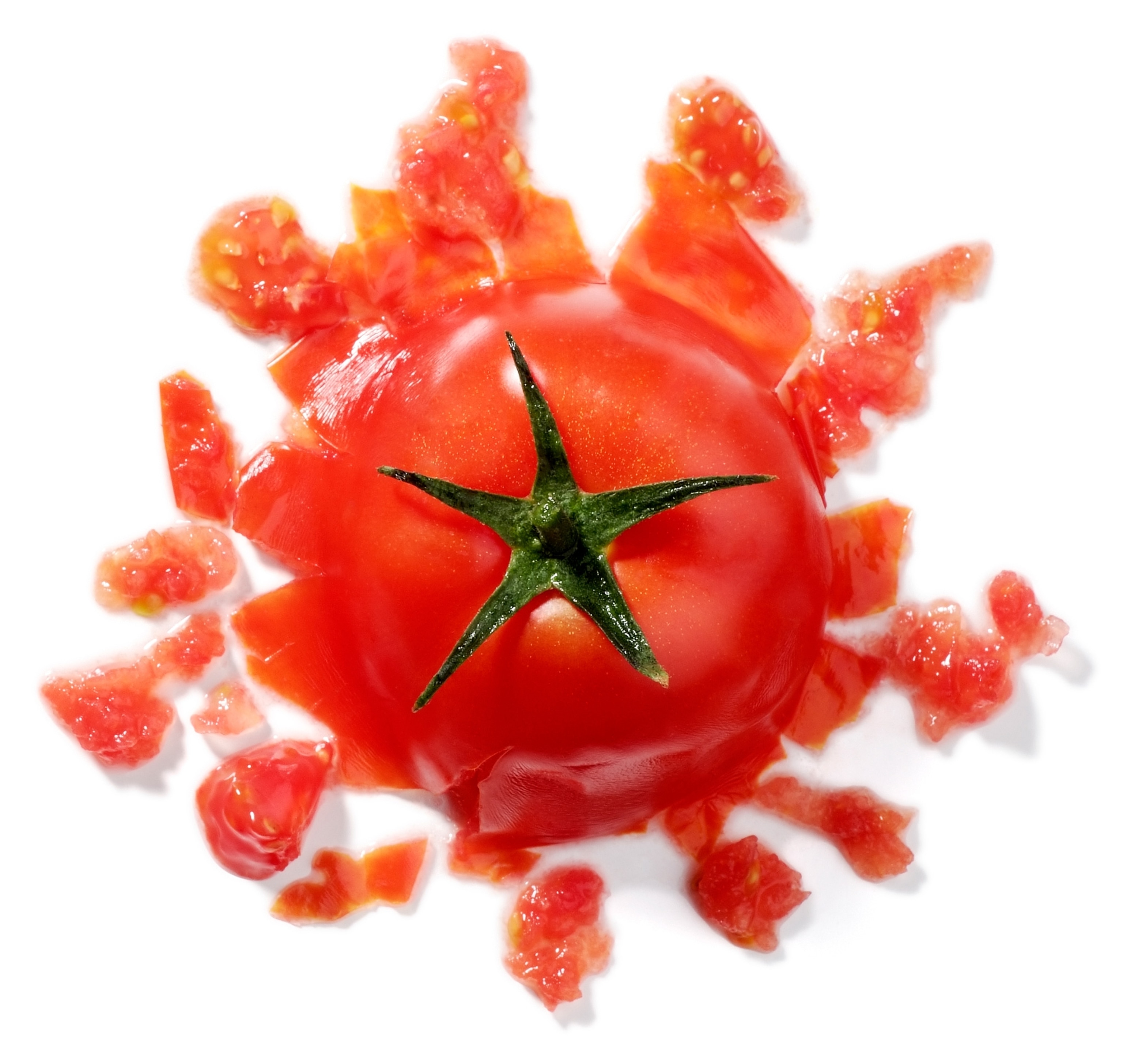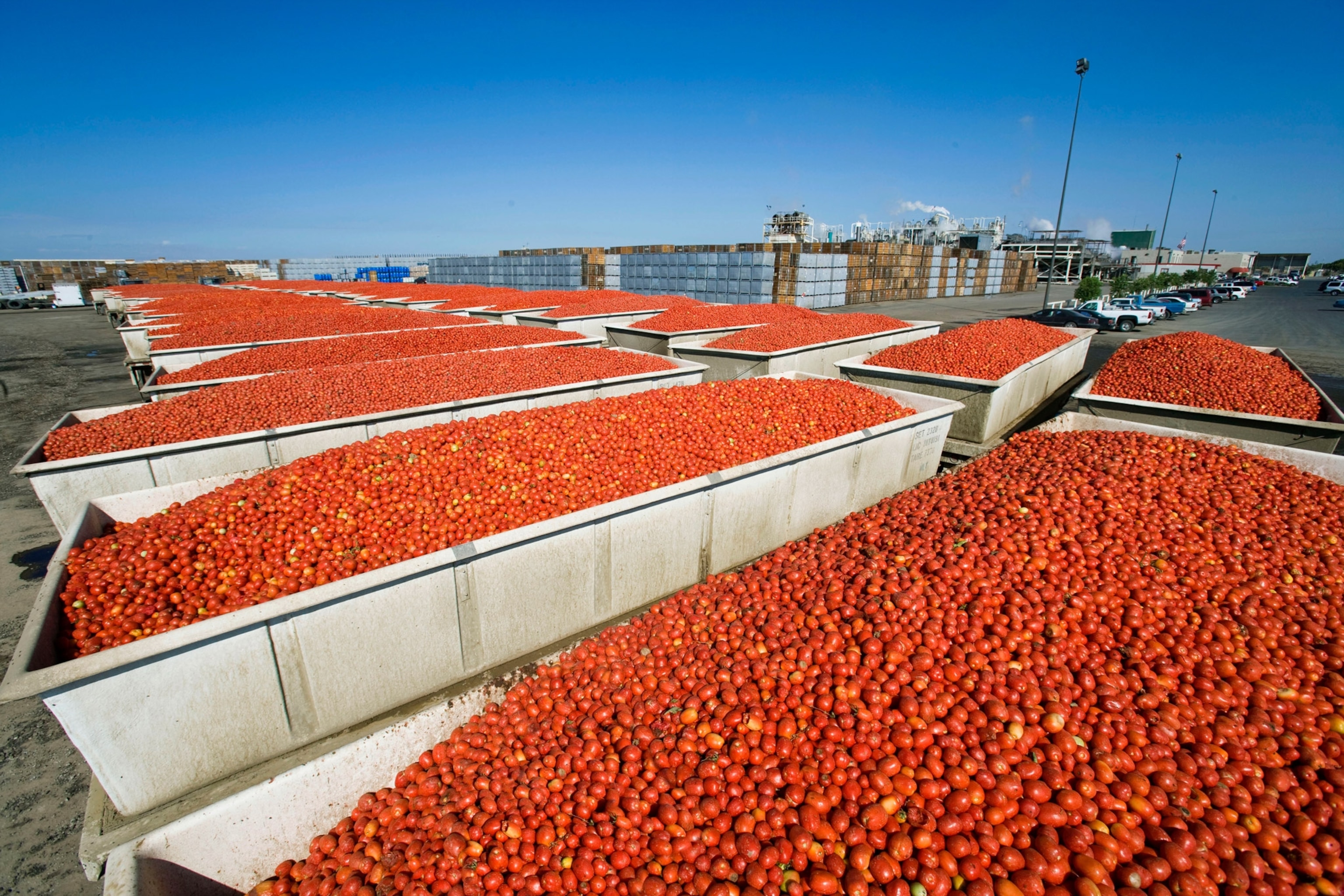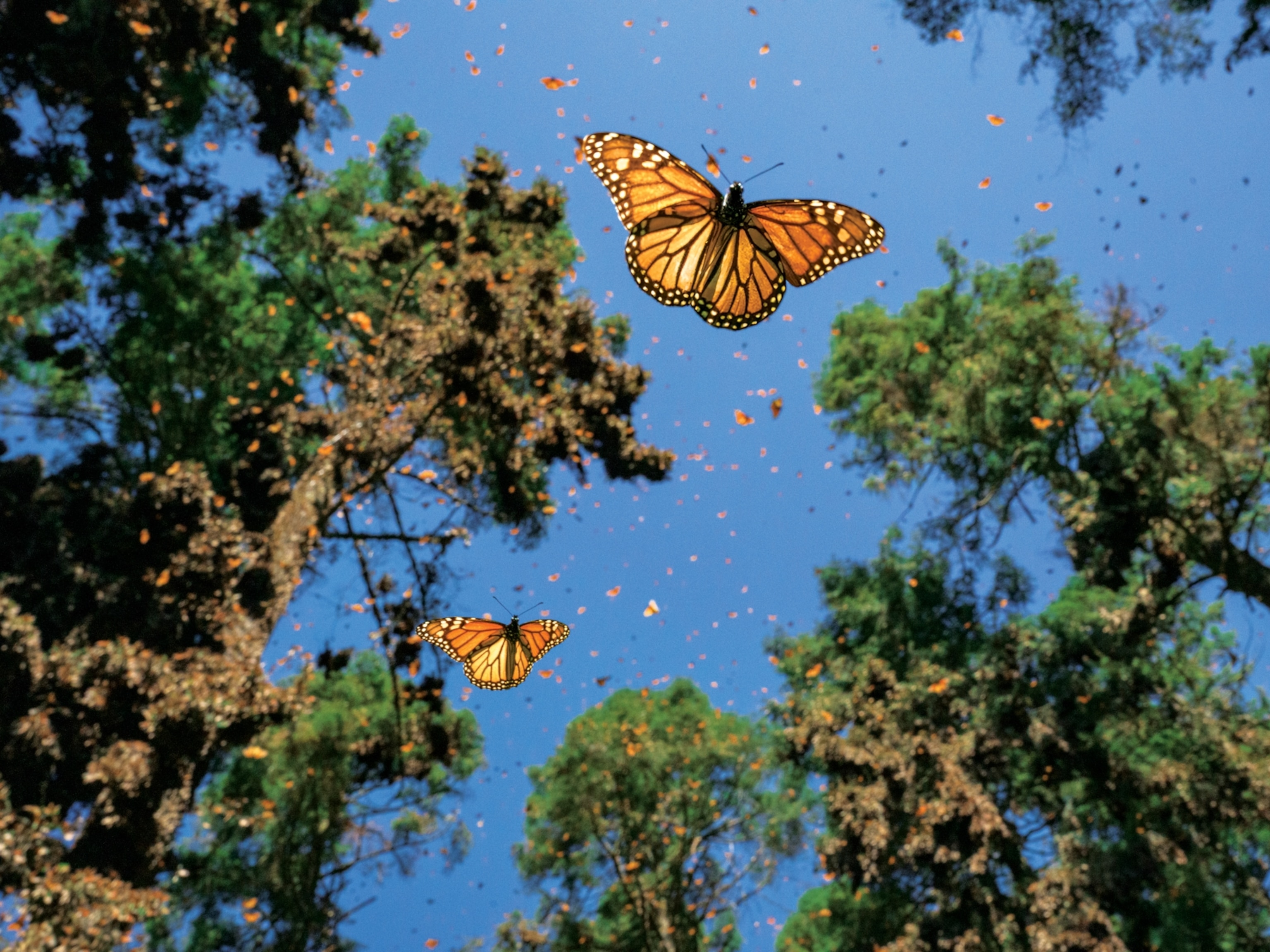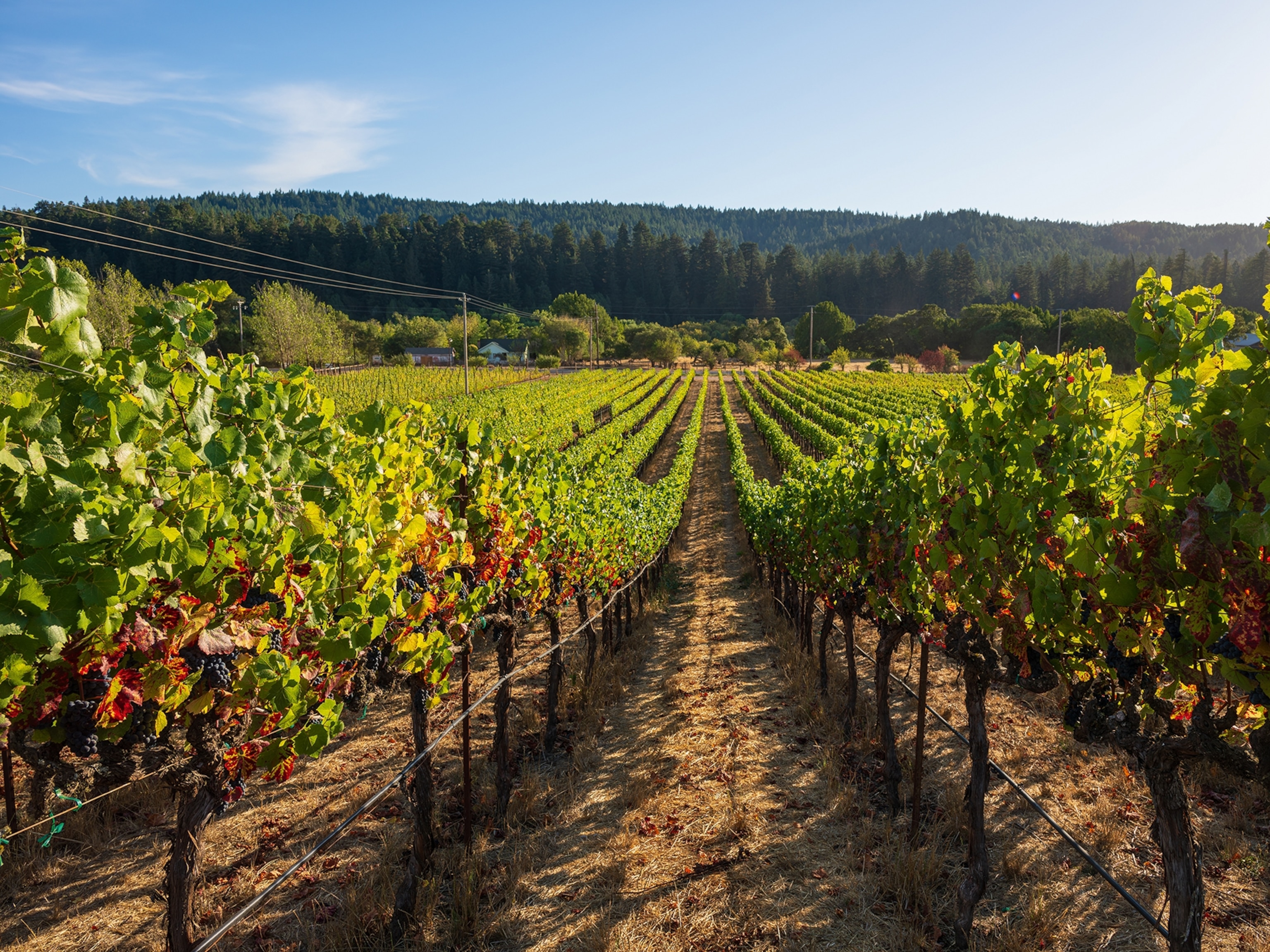Climate change is coming for your pizza sauce
Heat, drought, disease—climate-forced changes are pushing California tomato production into a tough spot. But our future pizzas are not yet lost.

FRESNO COUNTY, CALIFORNIA — It got really, really hot early last summer in California’s Central Valley. For days, temperatures spiked above 100 degrees Fahrenheit, well over the 30-year average.
Toward the south end of the valley, many farmers had only just planted their crop of tomatoes, and the heat wave hit at the exact worst time. Tomato plants aren’t particularly delicate, but they have limits—especially in their young, tender moments when their spikey yellow flowers bloom. The result? Many flowers “aborted,” withering on the vine. Those that already had been pollinated simply fell off and produced no tomatoes.
Weather problems affect agriculture all the time. But climate change is intensifying the challenges, making it harder to grow beloved foods like tomatoes. The effects are sometimes obvious, like the heat wave (made 150 times more likely by climate change), but also manifest more subtly: The climate-exacerbated ongoing drought has left growers far short on water, for instance. Warming winters are allowing pests and diseases to nose farther and farther north into new tomato territory.
Climate change isn’t necessarily the top-of-mind pressure for California growers. But it’s playing a role familiar to agriculturalists and experts around the world: It’s simply making everything harder.
“Usually we’re dealing with one problem at a time,” says Mike Montna, president of the California Tomato Growers Association. But now, “it feels like we’re all dealing with a lot all at once.”
And now, tomatoes—one of the most culturally beloved vegetables in the country—are starting to feel the pinch. The 2021 heat wave had big consequences: By the end of the season, growers across the state delivered about 10 percent less than the expected crop. That may not sound like a big deal, but it is, because California grows 90 percent of the country’s canning tomatoes—the second most valuable produce product the state exports. And even a 10 percent production drop left canners—who provide the tomatoes that become our pizza sauce, pasta sauce, and ketchup—in a tight spot. So this year, amidst an ongoing drought, everyone is hoping for a tomato-shaped success.

A tomato a day…
The scale of the obsession with tomatoes in the United States, where they’re the second most-consumed vegetable after potatoes, is enormous. The average consumer eats more than 30 pounds of them, or about 20 percent of their total vegetable intake, a year. The agricultural apparatus that keeps them available year-round is staggering.
“People love tomatoes,” says Montna.
Most of the time, people aren’t eating fresh tomatoes—they’re using canned, or paste, or eating them in pasta sauce, pizza sauce, soup, and all the other products made from tomatoes. And within the U.S., just about all those canned tomatoes—more than 30 percent of canning tomatoes in the world—come from a 300-mile long strip of California from Bakersfield to Yolo County.
“California is pretty unique in terms of its climate,” explains Tapan Pathak, an agriculture and climate expert at University of California, Davis. Long, sun-drenched summers with little or no rain is a “pretty perfect environment for tomatoes to grow,” he says. (Tomatoes don’t like getting their leaves wet).
That climate, along with historically rich soils, drew the industry to the region in the early 20th century, a time when water was being supplied plentifully to farmers across the state, the outcome of giant federal and state infrastructure projects that ferried water from the wetter northern half of the state toward the south.
But that water has become increasingly scarce, for reasons both political—as the state (and entire Western U.S.) confronts the ongoing overdraft of its invaluable water resources—and climate driven, as a warming planet “aridifies” the region, altering the very expectations about how much water will fall from the sky.
Last year, in fact, a team of climate scientists determined that the region was trapped in a “megadrought” that had continued, with brief intervals of historically more normal wetness, since 2000. That period, they found, was the most intense in the last 1,200 years. And climate change had undeniably made it more intense, longer lasting, and much more likely to have occurred.
Tomatoes under pressure
The reality of the drought really sank in last summer, when it wasn’t just record-breaking hot—it was record-breaking dry. Many farmers got only a fraction, if any, of the water they were used to from state and federal sources.
Already, tomato growers have slashed their water use: Since the early 2000s, most of the industry switched to buried drip irrigation, little tubes that put water and fertilizer right at the plants’ thirsty roots. The new strategy used a little less water and sent yields skyrocketing upward by 30 percent over about 10 years—an incredible gain of “crop for drop,” says Pathak.
But there aren’t many more water savings to be found. Now that less water is available, growers face hard decisions about where to put it.
Aaron Barcellos faces that exact dilemma. His family farms together on about 7,500 acres near Firebaugh, where they used to plant about 2,000 acres of tomatoes a year patchworked with cotton, asparagus, almonds, and lots of other fruits and vegetables.
But last year, the water shortages spooked him. The family put in only 900 acres of tomatoes. And this year didn’t look like it was going to be any better. So they planted 530 acres—just enough to honor his contracts with the canners up the road.
His son’s chocolate labrador, Moose, noses through young plants at one of the few recently planted tomato fields, sending up wafts of sharp, herbal scent.
“I don’t know if I’ll do more next year,” Barcellos says. Between the water stress and the enormous spike in other farm costs like tractor fuel and fertilizer—not to mention general inflation—unless canners want to pay a lot more for tomatoes next year, he’s not sure it will be worth it to grow them.
“It’s definitely the water situation that’s top of mind,” he says.
Barcellos has plenty of company. In 2019 and 2020, growers harvested 228,000 acres of tomatoes for about 11 million tons. Last year, the planned acreage was 231,000 and 12 million tons—but as the season progressed, the expectations dropped to 11.6 million tons, and then down to just 10.7 million.
It’s too early to know exactly how this season will play out, but R. Greg Pruett, a manager at Ingomar Packing Company in Los Banos, is blunt: “Our goal coming into this year was to run with the contract for as many tomatoes as we did last year, and we’re not going to achieve that goal,” he says. “The tomato acres are just not out there.” He estimates about 205,000 to 215,000 acres are growing now—far from nothing (that’s roughly the area of New York City—but far from enough for comfort.
The Ingomar plants run 24/7 for about 100 days from July to October, and they need about 600 loads total—a load is two trailers hauled behind a truck, 28 tons of bright red tomatoes—to feed into their massive bellies every day. The plan for how to source those tomatoes from growers across the state starts getting developed as soon as the previous season is over; it’s a delicate dance of guessing who can be enticed to grow them at what price, when the orbs will ripen, and which of the dozens of different varieties will need to be on site at the right moment to make each customer’s tomatoes the perfect blend of sweetness and acidity, juice and rich pulp.
A heat wave like last year’s? That messes with the plan. A drought as intense as the current one? That can change even more.
Pruett stands on a steel catwalk under a gleaming stainless-steel steam tank about four stories tall, looking out at the vast machinery that takes field-fresh tomatoes and turns them into one of the world’s most popular preserved vegetables. “The future of this crop can at times look on the bleak side, especially when you think about the drought. But this is still the best place in the world to grow them. I can’t see California not being the largest production area in the world,” he says.
It’s not just climate change that’s shifting the ground under tomatoes, of course. Pandemic and supply chain issues related to Russia’s war on Ukraine, inflation, and ever-tightening water restrictions are as big, and often seem more pressing to those on the ground.
But that, says Cassandra Swett, a tomato-focused researcher at UC Davis, is often how climate change makes itself felt—not just through catastrophic fires or hurricanes, but in slower ways. The effects of a single heat wave, or an ongoing drought, ripple outward from farm to processor, processor to commercial sellers, commercial sellers to your local pizza makers—and then to the consumer.
“But the overall implication is, tomato health is being affected not just by direct impact of climate change like heat, but also by indirect effects like drought and disease,” she says.
“If it doesn’t rain more next winter, we’re going to have even more problems,” says Montna. “That’s just the truth.”
The tomato ripples
At Zachary’s Pizza, a Chicago-style mini-chain in the Bay Area, tomatoes are the star. Each deep-dish pizza uses up to 24 ounces of tomato-based sauce—enough to fill three-fourths of a Nalgene bottle. That means the tomato quality and quantity really matters. “Our [California] tomatoes are the best in the world for what we do,” says owner Kevin Suto.
So far, Suto hasn’t yet felt the pinch of higher-priced tomatoes (or availability) but a constrained future worries him: “For us, we have no choice. We’re going to just have to grin and bear it,” he says.
Rob DiNapoli, a co-owner of Bianco DiNapoli, a canned tomato brand highly prized in the pizza industry, agrees. “Tomatoes are like gas. When they get more expensive, people just suffer more, pay more—they don’t stop using it.”
Tony Montagnaro co-runs Pinyon, a small restaurant in Ojai, California that specializes in pizza and California-sourced ingredients. “Great tomatoes are just a staple food,” he says. “Maybe pizza is running the risk of becoming a seasonal food, if there aren’t enough tomatoes in the future.”
Pizza is far from lost
No tomato growers are kidding themselves: It’s almost certain that growing the red fruit will get more challenging. For the last 30-some years, on average, the Central Valley would get five to seven days with temperatures above 100°F, a physiological threshold beyond which tomato plants stress out hard, says Pathak. But his work shows that by the end of the century, there could be 40-50 days that hot per year.
And Sarah Smith, a researcher at Davis, found that even one really hot day over 110°F drives a drop in both tomato yield and quality, costing a grower about one percent of their overall revenue.
“It’s not like a crop failure—it’s not a massive effect,” she says, “but when you’re in farming and operating on pretty small margins, every loss adds up.”
It’s getting harder and harder to find solutions. UC Davis’s Swett and Tom Turini are working constantly to help growers stay ahead of climate- and disease-related problems.
One promising idea was “deficit irrigation.” Turini tested how much water growers could save by shorting the plants a bit on their ideal water amounts during their last few months of growth, when they’re strong and well-established. His initial tests, run about a decade ago, looked promising: It seemed like growers could give them as little as half of what they wanted and keep the overall yield almost the same.
But over the years, more diseases and pests have crept into tomato fields, often driven by climate-warmed winters that fail to kill new arrivals.
So now, Turini is repeating the experiment—since stressed tomatoes, low on water, seem to be particularly vulnerable to pests and disease, just like how exhausted people are more susceptible to colds.
He bends down to examine a frilly plant laden with small, rock-hard green tomato-lets. They were planted about two months ago; come July, he’ll start cutting their water.
But even if he finds the deficit irrigation project won’t work, there will still be tomatoes growing across the Valley, he says—just fewer of them.
“The way we may have to save water now is just by growing less,” he says.
It’s unlikely scientists will find new breakthroughs that will totally climate-proof tomatoes, or send yields sky-high—nothing as short-term successful as the shift to drip irrigation. But geneticists at UC Davis and elsewhere are working hard to breed a more drought-resistant tomato, to fight diseases more effectively, and more efficiently grow—eking out gains wherever they can. In the meantime, she says, “farmers are super creative. They’ll adapt. It’s just a question of whether we [the public] are going to pay more,” enough to keep the industry humming.
But Suto, the pizza maker, is utterly confident. “People love pizza,” he says, “they’ll keep eating it, no matter what.”








